AGRONOMIC UPDATE – JUNE 4, 2021….Is Summer finally here?….
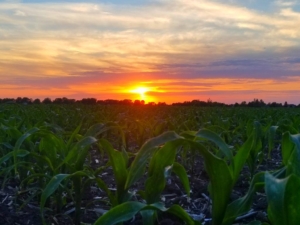
It feels like summer has finally arrived as temperatures are heating up over the next 7-10 days. Also, it feels good to see the ‘summer activities’ also showing up in our local communities…it is nice to return to a more normal condition!
TOPICS FOR THIS UPDATE:
- Temperatures/Precipitation & GDU accumulation
- What’s going on in my fields right now….
- Post Herbicide Reminders
- Staging Corn Growth Stages
- Rapid Growth Syndrome in Corn
- Insect Update
TEMPERATURES/PRECIPITATION & GDU ACCUMULATION:
As of June 3rd, we have accumulated approximately the following for Growing Degree Units in 2021:
Planting Date GDD’s2021 Average GDD Departure from average
April 24 467 437 + 30 (+ 1.5 days)
April 30 413 388 +25 (+1 day)
May 6 334 339 -5 (0 days)
As one can see from the above numbers, current GDU accumulation is basically normal for the area. This is a little surprising considering how cool it was in the first part of May and over last week. However, the next 7-14 day forecast is for above normal temperatures, so we should see gain in GDU accumulation vs. normal during this time frame. See maps below for the 6-14 day and three-month forecasts for temperatures and precipitation:
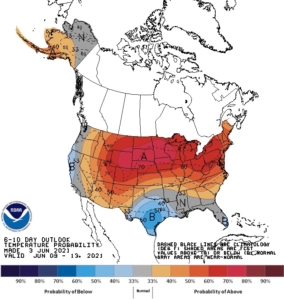
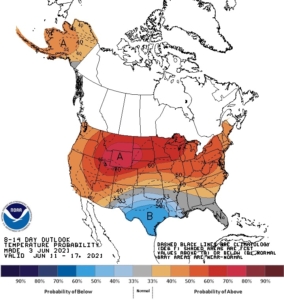
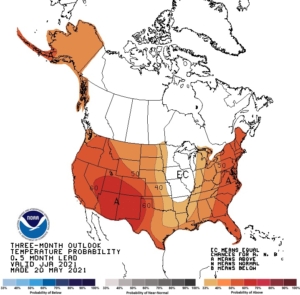
The above three maps are the current 6-10 day, 8-14 day and 3-month temperature outlooks. This forecast shows much-above normal temperatures for the next 7-14 days. The three month (Jun, Jul, Aug) forecast is for somewhat above normal temperatures for Nebraska. This is a slight change from the April forecast map of the same time period; at that time, all of the cornbelt was in a much-above normal temperature range.

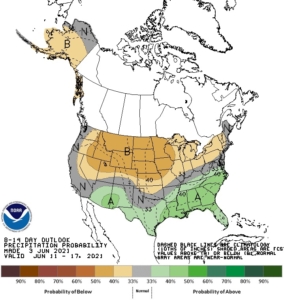

The next three maps show the 6-10 day, 8-14 day & three-month precipitation forecast. Local forecasts are calling for continued dry conditions for our area. Rainfall has been very spotty since planting and it looks like that will continue through the foreseeable future. However, the three-month forecast has also changed to normal precip from below-normal precip map in April. Antelope county is currently in the Extremely Dry category on the latest Drought Monitor map. As an update, my local weather stations shows we are currently at 49% of normal for the past 30 days and 38% of normal for the past 60 days.
WHAT’S GOING ON IN MY FIELDS RIGHT NOW?...
Overall much of the corn crop looks good. The majority of the crop is in the 4-5 leaf stage-of-growth depending upon planting date. From V1-V10, corn gains a leaf collar about every 83 GDU’s…this will be about every 3-4 days with current forecasted conditions.
- At about V5, leaf and ear shoot initiation will be complete and a microscopically small tassel is initiated in the stem apex tip, or top of the growing point. This is currently under or at the soil surface.
- At V6 (3-6 days from now for majority of the crop), the growing point and tassel will be above the soil surface and the stalk is beginning a period of greatly increased elongation.
- Determination of potential kernel rows around will be completed around V7 (range of V5-V8)…we are currently beginning this stage!
- The corn root system is now rapidly transitioning to the main nodal root system. When hot temperatures occur following a cold spell (like last weekend), crop growth at this stage can be uneven. Areas of heavy crop residue over the row will be slower due to cooler soil temps yet. It will take a little time for that to catch up.
- We are now heading into the rapid growth and accumulation of dry matter by the plant. The window for brittle snap will start to grow exponentially over the next few weeks.
- Watch temperatures as you are spraying post-herbicides on corn or beans over the next several days. When temps are in the 90’s and humidity is low, the potential for crop response from post-application of herbicides will increase. It is not recommended to be spraying during the heat of the day if temps are in the mid-upper 90’s…both for potential crop response and herbicide control.
POST HERBICIDE REMINDERS....
Timing is critical! Your pre-emerge herbicide has probably been on 3-5 weeks and residual is running out. Optimize your weed control success by scouting your fields: What weeds are present? How big are they? What growth stage is the crop? Once the weather warms up again both the crop and weeds will grow fast! Waterhemp/Palmer will go from 1″ to 8″ in a few days! Post applications should be going right now for the majority of corn planting dates.
Key reminders:
- Spraying when daytime temperatures are above 70 will improve herbicide performance and the rate of herbicide metabolism in the crop; however, on the flip side, spraying when daytime temperatures are 90 degrees or above will decrease plant uptake and increase crop response….this will be compounded if soil conditions are dry. When temps are approaching 90 degrees or above, do not spray in the ‘heat of the day’….
- Coverage is key! Use 15-20 gpa for optimal weed control….will need higher gallonage as crop and weeds increase in size.
- Check the herbicide label or website for correct adjuvants and qualified tank mix partners, especially for traited soybean applications (for Enlist E3 soybeans: enlisttankmix.com; Xtend soybeans: www.engeniatankmix.com or www.xtendimaxapplicationrequirements.com)
2021 Enlist BMP – Click Here
2021 Resicore BMP – Click Here
STAGING CORN GROWTH STAGES….
Staging Corn for Post applications Cutoff Time
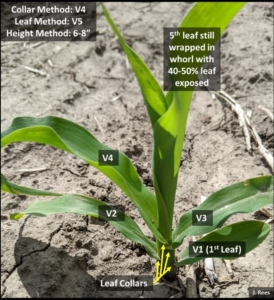
Accurately staging corn growth stage can implicate post applications in corn if applied at the wrong time. With the cooler weather the nodes can stack up and what looks to be V5-V6 corn may be V7-V8. Here is a good reference picture on how to stage corn with either the collar method (which is what most of us use) and the two others.
Quick Guide: Post Herbicide Cutoffs
RAPID GROWTH SYNDROME IN CORN….

Rapid growth syndrome usually occurs when corn leaves fail to unfurl properly and the whorl becomes tightly wrapped and twisted. It is generally associated with an abrupt transition from cool temperature to warmer conditions, which we are now experiencing. This syndrome usually occurs in the late V5 to early V6 stage, but can occur through and beyond V8-V9. Hybrids can also vary in there susceptibility to this.
The Good News: Yield doesn’t seem to be affected by the twisted growth. Once the plant is chest high the only evidence that remains is the leaves can have a crinkled appearance….this is also the yellow leaf phenomenon.
More info: Purdue Twisted Whorls in Corn
Crop Focus: Rapid Growth
INSECT UPDATE:
Alfalfa Weevil – Alfalfa weevil numbers are very high in area alfalfa fields. High probability that treatment will be warranted on most all fields to reduce impact on regrowth.
Click Here for Alfalfa weevil control: Click Here
Corn Rootworms –
It’s about that time to start seeing our annual rootworm hatch. When we see the cotton start to fly, or the famous lightning bugs, we will know rootworm hatch is underway because it takes about the same GDU’s (680-750 soil based degree days) for all of these things to happen.
Some fun facts:
- Larvae in sandy soils can become scratched and lacerated causing more mortality
- Flooded or saturated soils will cause more mortality
- Dry soil in late summer creates deep cracks for adult egg laying for better winter survival…which we had in 2020.
- CRW will go through 3 growth stages (Each last 7-10 days)
- 3rd Instar will create the most damage to corn roots
- Begin scouting continuous corn acres mid-to-end of next week and throughout the month of June.
There are many management practices that can help mitigate the risk of yield loss or lodging due to corn rootworm. The best recommended strategy is to rotate to soybeans.
CRW info: Corn Rootworm Management
GRANULAR INSIGHTS:
Granular Insights imagery is now ‘live’ and running with a new image showing up every 1-3 days. This imagery is an excellent scouting tool as well as diagnostic tool. Many growers already qualify for this imagery. Please contact us to get you set up on using this new tool from Pioneer and Granular.
Granular Insights Imagery and Remote Sensing: Click Here
Please contact us for any questions or concerns you may have! Thank you for your business!!
John Starman – 402-843-8393
Brandon Nielsen – 402-843-8907
Peter Starman – 402-843-0445

